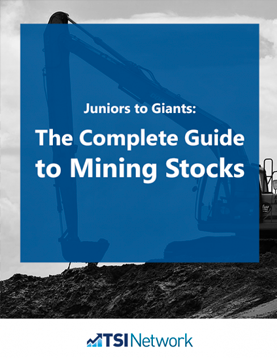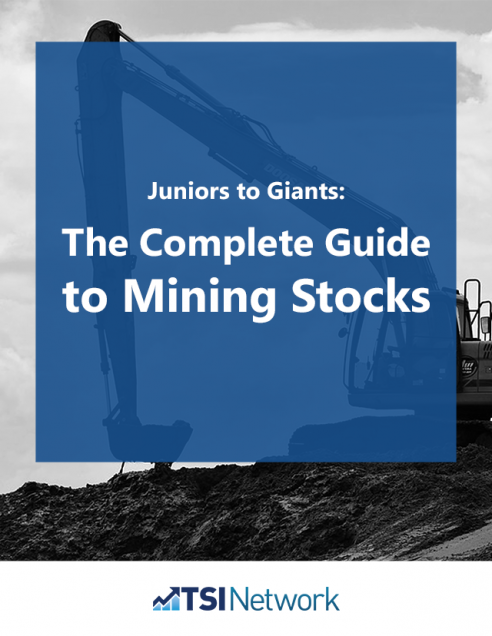Topic: Mining Stocks
Junior Mining Stocks and How to Invest Profitably
Junior mining stocks have strong profit potential—but they also have risk to match
Mining companies can generally be broken down into two categories, major and junior mining stocks. Majors are typically mining companies that have been in the mining business for many years and, more often than not, they operate producing mines on a global scale. Successful majors have proven methods for exploration and mining, and have consistent output, and cash flow, year over year. On the other hand, junior mining stocks are typically companies that have negative cash flow since they’re spending money in hopes of finding a mineable deposit.
Keep risk in mind with junior mining stocks
Even though junior mining stocks have strong profit potential, they entail higher risk than more established mining companies, for a number of reasons.
For one, the odds that the companies behind junior mining stocks will find an “anomaly,” or a geological formation that might attract a prospector’s interest, are slim. One rule of thumb is that you have to look at 1,000 anomalies to find one prospect. And fewer than one prospect in a thousand turns into a mine. In other words, finding a mine is a million-to-one shot.
Learn everything you need to know in 'The Complete Guide to Mining Stocks' for FREE from The Successful Investor. Best Canadian Mining Stocks TSX: Plus Gold Stocks, Canadian Diamond Mines and more.

How Mining Stocks make a difference
Another reason is that it’s much easier to launch and promote one of these stocks than it is to build a profitable business. So junior mining stocks attract more than their share of unscrupulous operators and stock promoters.
5 tips to help you cut your risk—and improve your profits—in junior mining stocks
Here are 5 guidelines we use to pick junior mining stocks we recommend in Power Growth Investor. We’re sure they can help you find the “gems among the rocks” in this fast-changing industry:
- We look for well-financed junior mines with no immediate need to sell shares at low prices. That’s because doing so would dilute existing investors’ interests.
- We like mining stocks with strong balance sheets and low debt. Junior mines should ideally have a major partner who can finance a mine to production.
- We want to see mining firms with experienced management with a proven ability to develop and finance a mine.
- When we recommend mining stocks, we want to see positive cash flow, preferably even when commodity prices are low. Even better, we like to see mining companies that have cash flow from an existing mine that is sufficient for, or at least contributes to, the cost of developing a second mine.
- We avoid junior mining stocks that trade at unsustainably high prices because of broker hype or investor mania. Instead, we focus on reasonably priced mining stocks with favourable geology.
4 things to look for before investing in junior mining stocks
- Focus on stable political regions We generally stay away from mining companies operating in insecure and politically unstable regions, such as the Congo and Venezuela, or in countries with little respect for property rights and the rule of law such as Russia or Mongolia. Mining is inherently a politically vulnerable business; you can’t move the mine to another country, and local citizens sometimes believe that a foreign mining company is robbing them of their birthright, even though they need the foreign company’s capital and expertise to get any value out of the ground.
- Look for steady production Some of the most highly promoted mining stocks, including gold mining stocks, are penny stocks that have yet to produce an ounce of gold or any other minerals. Many must still add to their reserves, invest in mine-feasibility studies, and raise a lot of money before they go into production. The prospects for most of these penny-mine properties, even though they may be in areas with production from existing mines nearby, are far from certain.
- Look for longevity and strength in reserves when considering mining stocks When you invest in any resource stock, gold included, you need to look at how long the company’s reserves are likely to last. Those with low reserves need to have consistent success in their exploration programs to maximize the production of the mine and the surrounding area. That success is far from guaranteed.
- Seek low production costs and mines that are already producing Good mining stocks have a range of development projects, but their strong base of low-cost production cuts the risk of relying on new developments alone.
The best investment strategy for junior mining stocks meet these 4 criteria
- Invest in well-financed mines with strong balance sheets We look for well-financed mining stocks with no immediate need to sell shares at low prices, since that would dilute existing investors’ interests. The best junior miners have a major partner who has agreed to pay for the drilling or other exploration or development, in exchange for an interest in the property. The best mining stocks all have strong balance sheets and low debt.
- Avoid buying mining stocks that trade at unsustainably high prices This is usually due to broker hype or investor mania about the underlying commodity (such as gold). Instead, we focus on reasonably priced mining stocks with favourable geology.
- Look at future demand For example, rare earth stocks should grow over the coming years. The world’s demand for high-end rechargeable batteries is increasing, and the rare earth refinement process will also become less toxic. This opens up opportunities to mine in more environmentally strict jurisdictions.
- Look at the market cap of mining stocks We look at the market cap of mining stocks–including junior mining stocks–versus the estimated value of the mineral resource they have in the ground. Sometimes, a company’s marketing efforts are so successful that they drive the stock up too high in relation to the size of its ore body. We like a mining stock’s market cap to be no more than half the value of the mine. We assume that the company will be able to expand its reserves after the mine opens, but if the reserves are double the mining stock’s market cap, it provides a margin of safety.
Bonus Tip: Pros and cons of flow-through funds
Flow-through entity funds are tax shelters that mainly invest in the flow-through shares issued by junior mining and oil companies. These companies spend the proceeds from the shares they sell on mineral exploration and development, an activity that qualifies for certain tax credits and tax deferrals. These tax benefits “flow through” to investors in the fund. In general, to take advantage of these benefits, investors need to hold the funds for a fixed period, usually 18 months to two years.
Investors buying into flow-through limited partnerships are able to deduct 100% or more of their investment against income by the end of the second year. This leaves the investor with an adjusted cost base on the units of zero. When you subsequently redeem or sell the limited partnership units, you pay capital gains on the entire balance of the sale.
However, the problem with these tax shelters is that they may persuade you to make a risky investment you wouldn’t otherwise make. Moreover, a portion of the benefits are set aside for brokers and the fund’s organizers. What’s left may not be enough to pay you for taking on the extra risk.
These tax shelters may post excellent results in booming commodity markets (like 2022’s) from time to time. However, resources and commodities booms never last forever.
Keep in mind that most flow-through issuers are junior companies that are short on financing, or don’t have enough income to make full use of the tax benefits associated with their exploration. That’s why they sell these benefits to investors.
One big drawback in flow-through limited partnerships is that many of the flow-through mining and energy stocks they invest in are highly speculative. The partnerships are also usually in a hurry to invest their money to pass the tax deductions on to their investors as quickly as possible. That can lead to some hasty stock selections.
Rather than invest in flow-through entities, we think you are much better off keeping things simple and investing in strong mining stocks.
Follow our three-part Successful Investor strategy
- Invest mainly in well-established companies;
- Spread your money out across most if not all of the five main economic sectors (Manufacturing & Industry; Resources & Commodities; the Consumer sector; Finance; Utilities);
- Downplay or avoid stocks in the broker/media limelight.
Do you own any junior mining stocks? How have they performed in your portfolio? Share your experience with us in the comments.
This article was originally published in 2017 and is regularly updated.




WHY THE BREAKOUT IN URANIUM STOCKS a (short squeeze) MY favorite just bought last week U.TO
Thanks for your view on this uranium stock.
THE DOLLAR has lot to do with the run in commodities
you can make huge profit’s on short squeeze breakout’s just need to know where to look!
Thanks for your comment.